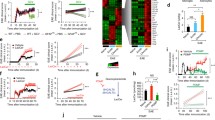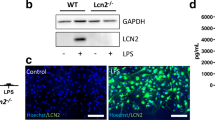Abstract
CLEC16A, C-type lectin domain family 16, member A was recently found to be associated with inflation process in the autoimmune diseases. In this study, we elucidated the dynamic expression changes and localization of CLEC16A in lipopolysaccharide (LPS)-induced neuroinflammatory processes in adult rats. CLEC16A expression was strongly induced in active astrocytes in inflamed cerebral cortex. In vitro studies indicated that the up-regulation of CLEC16A may be involved in the subsequent astrocyte activation following LPS challenge. And Knock-down of CLEC16A in cultured primary astrocytes by siRNA showed that CLEC16A was required for the activation of astrocytes induced by LPS. Collectively, these results suggested CLEC16A may be important in host defense in astrocyte-mediated immune response. Understanding the cell signal pathway may provide a novel strategy against inflammatory and immune reaction in neuroinflammtion in CNS.





Similar content being viewed by others
Abbreviations
- CLEC16A:
-
C-type lectin domain family 16, member A
- TNF-α:
-
Tumor necrosis factor-alpha
- LPS:
-
Lipopolysaccharide.
- CNS:
-
Central nervous system
- PAGE:
-
Polyacrylamide gel electrophoresis
- ECL:
-
Enhanced chemiluminescence system
- RT-PCR:
-
Reverse transcriptase PCR
- GFAP:
-
Glial fibrillary acidic protein
- NeuN:
-
Neuronal nuclei
- PCNA:
-
Proliferating cell nuclear antigen
- GAPDH:
-
Glyceraldehyde-3-phosphate dehydrogenase
References
Paul AF, Anne-Marie W, Himali BF et al (2005) Inflammation and primary demyelination induced by the intraspinal injection of lipopolysaccharide. Blood 128:1649–1666
McGeer LP, Itagaki S et al (1988) Reactive microglia are positive for HLA-DR in the substantia nigra of Parkinson’s and Alzheimer’s disease brains. Neurology 38:1285–1291
Liu B, Hong JS (2003) Role of microglia in inflammation-mediated neurodegenerative diseases: mechanisms and strategies for therapeutic intervention. J Pharmacol Exp Ther 304:1–7
Rosi S, Ramirez-Amaya V, Vazdarjanova A, Worley PF et al (2005) Neuroinflammation alters the hippocampal pattern of behaviorally induced Arc expression. J Neurosci 25:723–731
Ridet JL, Malhotra SK, Privat A et al (1997) Reactive astrocytes: cellularand molecular cues to biological function. Trends Neurosci 20:570–577
Volterra A, Meldolesi J (2005) Astrocytes, from brain glue to communication elements: the revolution continues. Nat Rev Neurosci 6:626–640
Mark AR, Gareth RJ, Xianyuan S et al (2005) The cytokine IL-1βactivates IFN response factor 3 in human fetal astrocytes in culture1. J Immunol 174:3719–3726
Eddleston M, Mucke L (1993) Molecular profile of reactive astrocytes–implications for their role in neurologic disease. J Neurosci 54:15
Dong Y, Benveniste EN (2001) Immune function of astrocytes. Glia 36:180
Streit WJ, Walter SA, Pennell NA (1999) Reactive microgliosis. Prog Neurobiol 57:563–581
Liu L, Rudin M, Kozlova EN (2000) Glial cell proliferation in the spinal cord after dorsal rhizotomy or sciatic nerve transection in the adult rat. Exp Brain Res 131:64–73
Olivier N, Anna G, Cecily EH et al (2005) Activation of protease-activated receptor-1 triggers astrogliosis after brain injury. J Neurosci 25(17):4319–4329
Carla C, Daniela D, Helgi BS et al (2007) Activation of melanocortin 4 receptors reduces the inflammatory response and prevents apoptosis induced by lipopolysaccharide and interferon-γ in astrocytes. Endocrinology 148(10):4918–4926
Hakonarson H, Grant SF, Bradfield JP et al (2007) A genome-wide association study identifies KIAA0350 as a type 1 diabetes gene. Nature 448:591–594
Consortium The Wellcome Trust Case Control (2007) Genome-wide association study of 14, 000 cases of seven common diseases and 3, 000 shared controls. Nature 447:661–678
Hafler DA, Compston A, Sawcer S et al (2007) Risk alleles for multiple sclerosis identified by a genomewide study. N Engl J Med 357:851–862
John AT, Neil MW, Jason DC et al (2007) Robust associations of four new chromosome regions from genome-wide analyses of type 1 diabetes. Nat Genet 39(7):857–864
Shah VB, Huang YC, Keshwara R et al (2008) β-Glucan activates microglia without inducing cytokine production in Dectin-1-dependent manner. J Immunol 180:2777–2785
Aloisi F (2001) Immune function of microglia. Glia 36:165–179
Kreutzberg GW (1996) Microglia: a sensor for pathological events in the CNS. Trends Neurosci 19:312–318
Farina C, Aloisi F, Meinl E (2007) Astrocytes are active players in cerebral innate immunity. Trends Immunol 28:138–145
Jack CS, Arbour N, Manusow J et al (2005) TLR signaling tailors innate immune responses in human microglia and astrocytes1. J Immunol 175:4320–4330
Gehrmann J, Banati RB et al (1995) Amyloid precursor protein (APP) expression in multiple sclerosis lesions. Glia 15:141–151
Sylvain N, Serge R (2000) Role of microglial-derived tumor necrosis factor in mediating CD14 transcription and nuclear factor k B activity in the brain during endotoxemia. J Neurosci 20(9):3456–3468
Stadlin A, Tsang D, MacDonall JS et al (1992) An in vitro study on increased neuronal and astrocytic vulnerability to neurotoxic injury after in utero cocaine exposure: the reversal effects of GM1 treatment. Prog Brain Res 94:339–350
Morris GF, Mathews MB (1989) Regulation of proliferating cell nuclear antigen during the cell cycle. J Biol Chem 264:13856–13864
Geijtenbeek TBH, Sonja IG (2009) Signalling through C type lectin receptors: shaping immune responses. Nat Rev Immunol 7:465–479
Zhao G, Flavin M (2000) Differential sensitivity of rat hippocampal and cortical astrocytes to oxygen-glucose deprivation injury. Neurosci Lett 285:177–180
Smith SJ (1992) Do astrocytes process neural information? Prog Brain Res 94:119–136
Mun˜ oz-Fernandez MA, Fresno M (1998) The role of tumour necrosis factor, interleukin 6, interferon-gamma and inducible nitric oxide synthase in the development and pathology of the nervous system. Prog Neurobiol 56:307–340
Ana G, Sergio S, Vittorio G (2008) Endothelin-1 regulates astrocyte proliferation and reactive gliosis via a JNK/c-jun signaling pathway. J Neurosci 28(10):2394–2408
David MU, Eddie R, Clifford AL et al (2005) Dectin-1 activates Syk tyrosine kinase in a dynamic subset of macrophages for reactive oxygen production. Blood 106:2543–2550
Acknowledgments
This study was supported by the National Natural Science Foundation of China (No. 81070992) and A Project Funded by the Priority Academic Program Development of Jiangsu Higher Education Institutions (PAPD).
Author information
Authors and Affiliations
Corresponding authors
Additional information
Yilu Gao is the first corresponding author.
Xinmin Wu and Jing Li contributed equally to this work.
Electronic supplementary material
Below is the link to the electronic supplementary material.
Rights and permissions
About this article
Cite this article
Wu, X., Li, J., Chen, C. et al. Involvement of CLEC16A in Activation of Astrocytes After LPS Treated. Neurochem Res 37, 5–14 (2012). https://doi.org/10.1007/s11064-011-0581-4
Received:
Revised:
Accepted:
Published:
Issue Date:
DOI: https://doi.org/10.1007/s11064-011-0581-4




